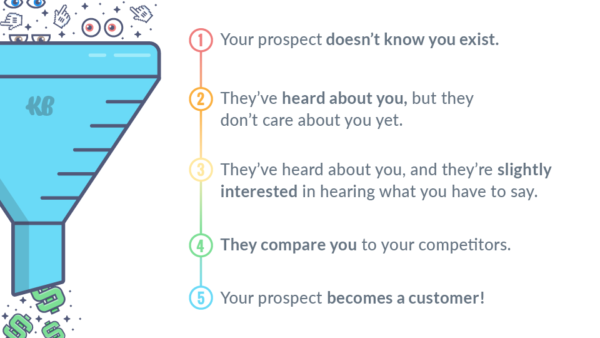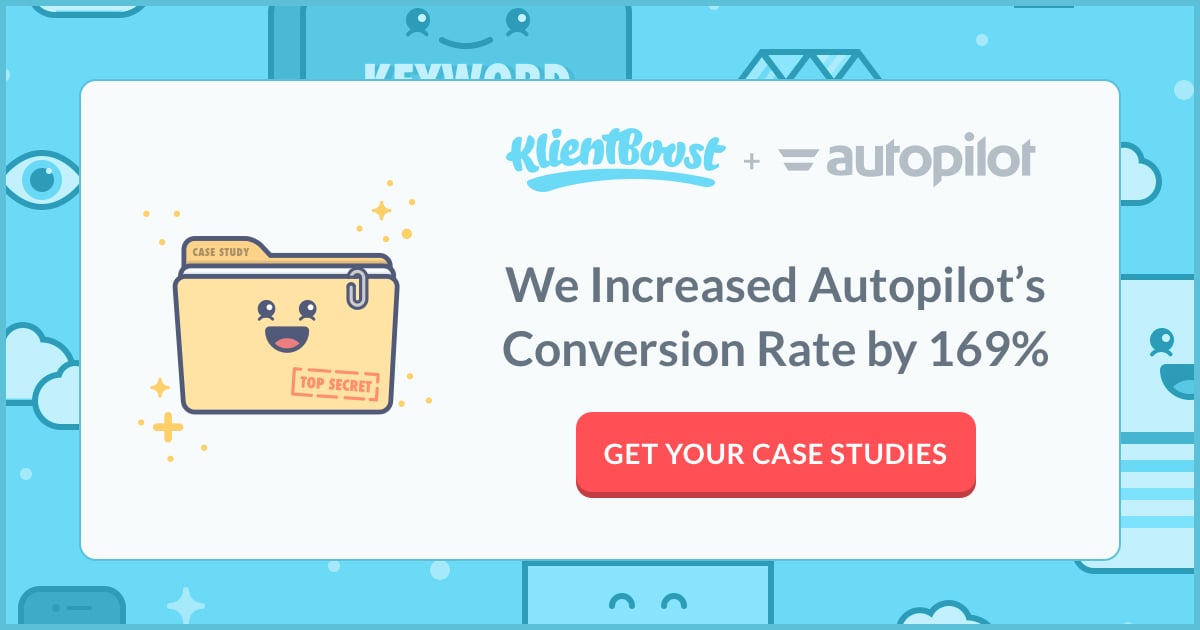What would you think if you were in the produce aisle at the grocery store and there was a sign that said “watermelons on sale” over a stack of mangoes?
You’d probably think someone put the sign in the wrong place.
But then you’d wonder if the mangoes were supposed to be on sale? Maybe you’d scan around for the watermelons. Or maybe there's a produce person who can clarify if that sign was supposed to say “mangoes” or if it belonged wherever the watermelons are.
Sadly, there's no one around to sort out this quandary, so you push your cart over to the kiwis and strawberries and think maybe you’ll come back tomorrow once the mango/watermelon confusion is sorted out.
Or not. I mean, you already have other yummy fruit now.
👆 That confusion happened because there was a message mismatch.
The sign didn’t match the fruit so you pushed your cart away—with a slight tingle of negative discord buzzing in your brain.
If that happens in digital marketing, you're screwed.
In this post, we’ll break down what message match is (or isn’t) with examples, explain the difference between bad (avoid), good (you can do better), and great message match (aim for this), and describe how the effect of consistency tumbles throughout your PPC campaigns in a conversion-happy way.
Because nobody wants to find out they’re inconsistent and screwed.
Get brand new conversion strategies straight to your inbox every week. 23,739 people already are!
What is message match?
The phrase “message match” describes how well your landing page copy and design matches the copy and design of the ad that brought your visitor there.
A great message match is reassuring. It tells ad clickers that they’re in the right spot to find out more about what the ad promised.
The simplest way to create that “I’m in the right place” reassurance is to make sure the headline on both the ad and landing page are the same.
In the fruit example we used at the start, your pay per click (PPC) ad is the fruit sign. When it didn’t match the landing page (the stack of mangoes), it created a disconnect (a mismatch in the message between those two things).
So take this simple nugget with you as you read the finer points of this post:
The message and the look of your ad campaign should match from ad to landing page to thank you page—consistency is key to conversions.
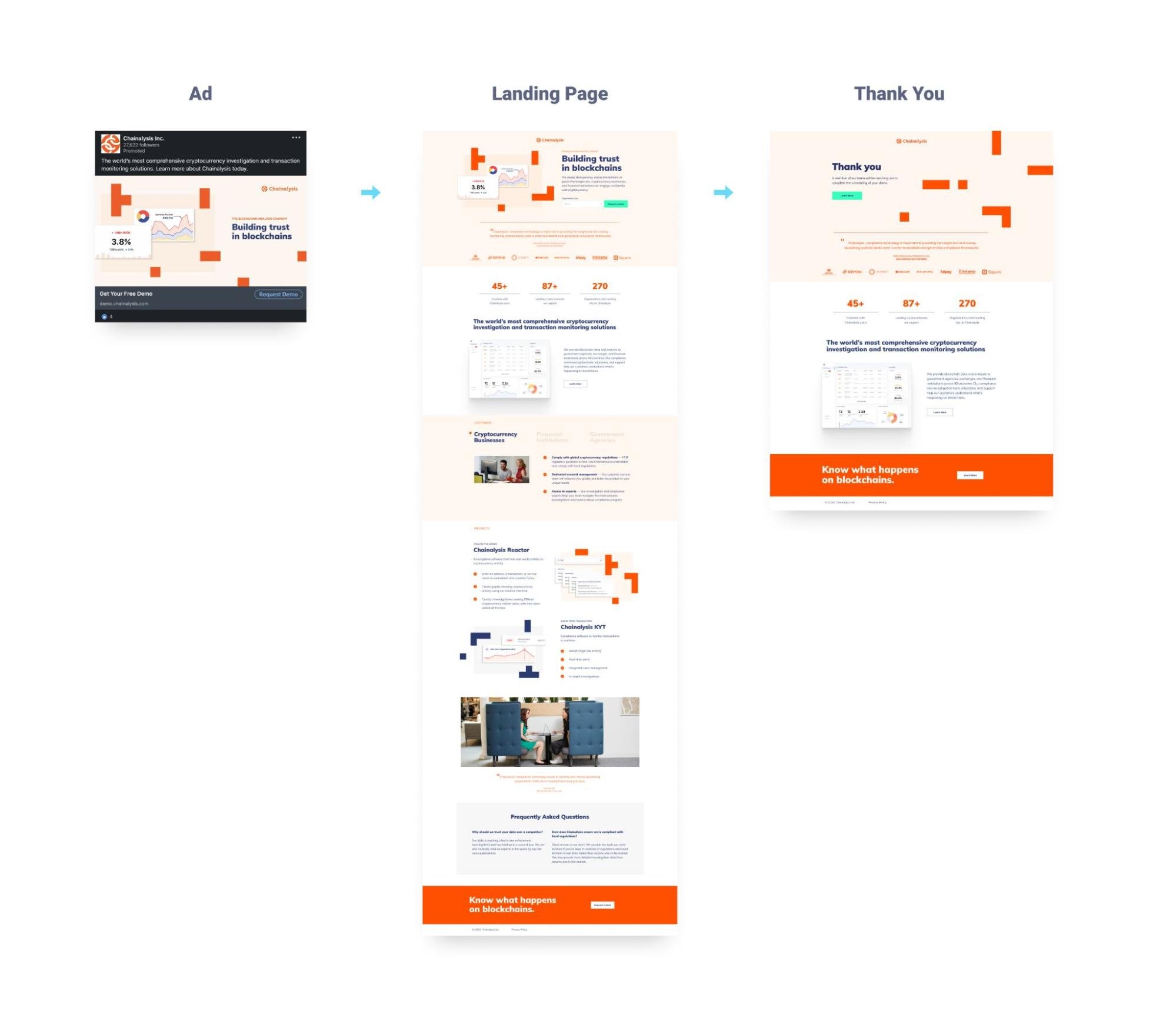
What’s the difference between a good and bad message match?
To be clear, there are three types of message match:
- Bad message match
- Good message match
- Great message match
Tons of advertisers run campaigns with a bad message match. Just as many advertisers do a fairly decent job of making sure their message match is pretty good, meaning their ad headline lines up with their landing page headline.
But very few advertisers manage to pull off a great message match.
If you’re here, it’s because you’re ready to figure out how to pull that off. And you should want to learn about great message match because it’s an online marketing tactic that increases conversions and, when that happens, money rains down from the sky.
Bad message match
A bad message match means there’s no match. The watermelon sign is creaking in the air conditioning over the mangoes and all the fruit shoppers roll by with nothing but question marks in their cart.
With a bad message match, you’ll lose potential customers and spend more than you make 😭
Sadly, poor message match examples exist all over the internet.
Remember that your ad is a teaser that convinces someone to click through to your landing page. If your ad doesn’t look or sound the same as the page that follows the click, that falls into the realm of false online advertising. All that happens, in that case, is a bounce for a sneaky bait and switch.
But why would you intentionally create that confusion?
You wouldn’t, but it happens all the time.
It might not be intentional, but it’s definitely dumb.
What makes a message match great?
We love that question.
If you know what you’re doing, you intentionally pin relevancy and consistency to your campaign from beginning to end.
Whatever you promise with your PPC ad copy, carry that over to your specific landing page copy—predominately your headline—so your visitor knows that they’re at the right place and that your solution is exactly what they need to fix their problem.
If the landing page answers the questions the prospect had that caused them to click the ad in the first place, that’s a great message match, and your chance of clinching a conversion goes up.
Don’t settle for good enough. Fill in all the blanks and leave nothing to the user. This isn’t a book, it’s marketing. Asking the user to make connections with “pretty close” message match could cost you some serious money.
Let’s take a look at the great message match example:
When we added "Fully Free for Life" messaging to Chat Support’s ad copy and landing page, we saw a 66% lift in conversion rate.
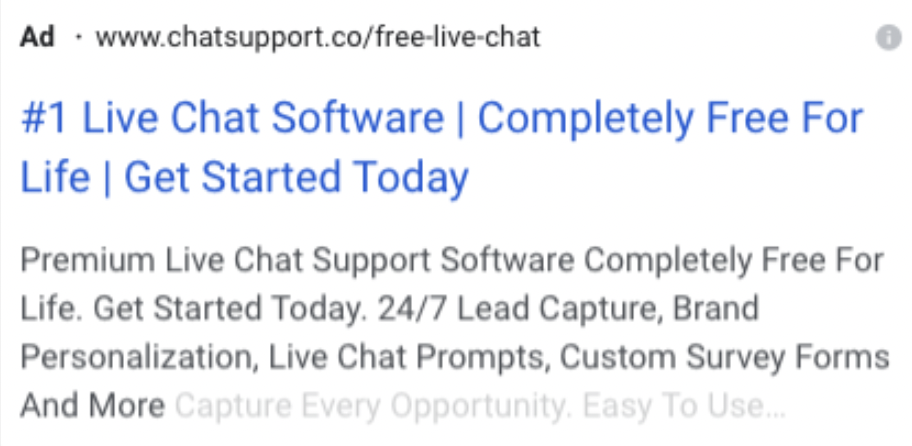
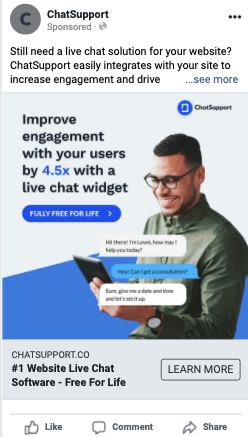
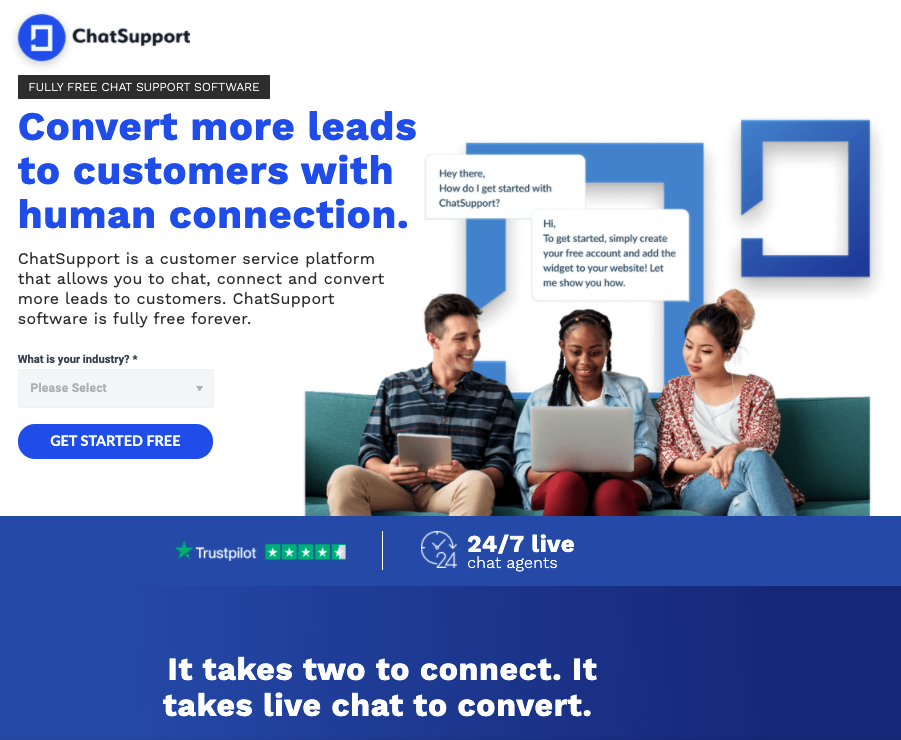
Users know when they click through from the ad to the landing page that they are where they were supposed to go. The message is the same.
Recognizing that the landing page is relevant to the promise made by the ad makes for a great message match.
Great message match removes any doubt. It requires no reading between the lines or any deduction or any leaps in logic.
✨ The reward for that clarity is an increase in conversions ✨
And that’s because your stellar message match positively affects two things:
- Pay-per-click (PPC) campaign success
- Conversion rate optimization (CRO) success
It’s a circle: PPC holds hands with CRO. What happens to one, alters the success of the other.
If you want a great message match, your promise needs to appear in your headline copy and subhead copy exactly as it appears in your PPC ad copy.
When a visitor lands on your designed landing page, their eye immediately searches for something to identify with, telling them that they’ve come to the right place.
No one likes wasting time, so that mental handshake is a baseline necessity.
Headline message match
Your headline (also called the H1) is the “big intro” to your landing page. That’s where their eye goes first. So that’s where the initial match and recognition happens, getting them to exhale and stay.
Subheadline message match
Not all landing pages will have, or will need to have, subhead copy. That’s the supporting line to the headline copy (also called the H2).
If you do use subhead copy, make sure it adds value to the headline (H1), strengthening the same message for an even better message match.
Quality score
On the PPC ad side of the circle, a great message match increases your quality score. Google defines quality score as an estimate of the quality of your ads, keywords, and landing page.
Higher-quality ads can lead to lower cost per click and better ad position.
How does the CRO side of the circle play into that?
CRO score
CRO is how well your landing page convinces your visitors (via design and copy) to stay and convert—doing the thing you wanted them to do, which is click your call-to-action button (CTA).
If your landing page copy matches the PPC ad message, delivering on its promise, you’ll have better conversion rate results.
When that happens, your PPC ad gains credibility.
It now looks better to Google, which potentially gives you a stronger search ad position on the search results page (SERP).
The better your PPC ad looks to Google (the search engine), the higher you’ll rank, and the more traffic you’ll see visiting your landing page.
At that stage, the better your CRO, the more conversions you drive, completing and strengthening the virtuous circle.
Do you see how a poor message match might affect all of that? It’s a downward spiral.
So keep things tightly matched.
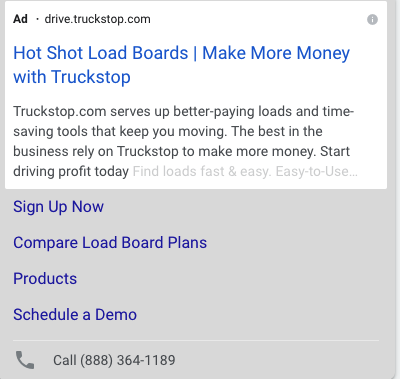
And the landing page...
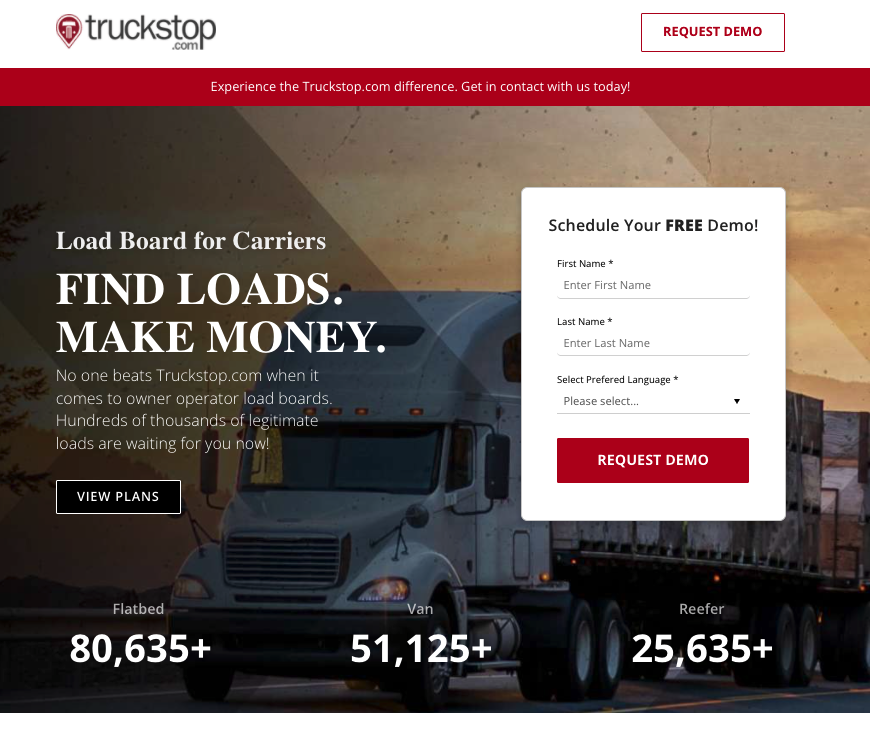
There’s no confusion there 👆
That’s a match between the search ad and the landing page 🙌
Remember that graphic components speak to message match too, the same as the copy does. Your viewers identify the visual on the ad, and that reinforces the landing page when it’s in both places. A display ad for Truckstop would do well if the exact same image was used on the ad as the landing page hero section.
11 message match tips to clinch conversions
Now that you have a solid understanding of what message match is, here are 11 solid tips to ensure you're mastering the message match and capturing every conversion possible.
1. Use dynamic text
We used to be bogged down in a world where you had to create a unique landing page for every keyword that you’re bidding on. This can be quite a daunting chore if you need a ton of variations and can require heavy design and development efforts.
Dynamic text replacement allows you to create one landing page for each of your ad groups. This helps you personalize and scale your campaigns by encompassing multiple keyword variations.
For example, if someone is looking for a hiking backpack vs a trekking backpack, you can tailor not only your PPC ad copy to the individual search, but you can also insert dynamic keywords into your landing pages like this:
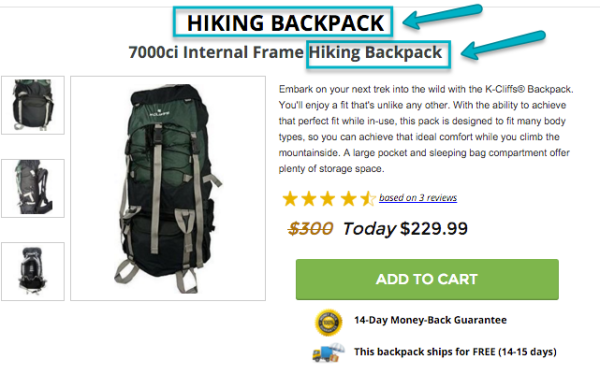
OR

Without having to create a separate landing page for each ad group, dynamic text replacement can automatically take care of your message match for you. Use the same dynamic keywords in both your PPC ads and landing pages.
2. Use target personas
Think personalization. You can do general keyword research, but that isn’t going to tell you what words/phrases resonate most with your specific target audience.
Before you start crafting ads and landing pages, you want to outline your target personas. What are their needs, interests, and what does your ideal customer look like. You can have more than one target persona.
Laying out these details can help you decide how many variations of ads and landing pages you need. Perhaps, one ad serves multiple target personas, but you’ll need 4 landing page variations. The ratio doesn’t always need to be 1:1.
Being more granular isn’t always best. You can get too granular, too quick. It may only take one wrong message to turn a visitor away. So, maybe start a little broader with your personas and as you get more data from your campaigns, make edits to ads and landing pages.
3. Consider the user’s intent
You may have two different prospects with very different intents. For instance, one may be looking to buy a new vacuum cleaner while the other wants to hire someone to fix their vacuum cleaner. Perhaps, you offer all vacuum-related services, but the way you are going to attract the prospects is different.
You can take the temperature of your audience to see if they are actively seeking your product/service, or perhaps they haven’t even realized they have a need for it yet.
Don’t start out with an ad that offers free information and jump right into asking for a proposal on the landing page. Even if the proposal is related to the informational topic, your prospect may not be ready to commit on that level.
4. Keep copy localized
You can use specific area code-based phone numbers in both your PPC campaigns and your landing page messaging.
In the same way that a specific area code brings relevancy to your visitors, by mentioning the city that your visitor is in, you can appear to be local and familiar to your audience.
If I saw a 949 area code on an ad and then saw a 408 one on a landing page, I might question if it was a typo or if this was a legit business. Which one should I call? It may not even be worth my time to try to figure it out.
Since you have already defined your buyer personas, you probably have a few core geographic regions for which you would like to start out. Knowing this saves you time in securing a number for every area code in existence.
5. Match the scentand design
Matching scent means matching the look, feel, tone, and personality of your PPC ad to your landing page message. Use connected images and color schemes to achieve this.
Here is an example of a campaign we have showcasing one of our case studies:
Despite what you might think, a landing page doesn’t always have to look pretty in its design and imagery to convert, so really give some thought to the message you are trying to convey with both, and let that guide your decisions.
6. Match the copy
Phrasing, primary ad copy, secondary ad copy, word choice are all things you can match. Go a step further and match your subheaders.
Your secondary information can be the part of your PPC ad that drew in your audience to click, but just be sure to capture that same verbiage on your landing page too -- to assure visitors they’re in the right location.
You can then add supplemental information that the visitor might need to move to a point of conversion.
Further reading: Landing Page Copywriting: Write To Engage and Convert
7. Match the keywords and CTA
I previously mentioned how user intent should guide the message and this includes keyword selection. Choose high-intent keywords to highlight and match to start.
Note: A lot of keyword research tools show search overall rather than for your specific audience so for the right audience, a keyword may really pay off where it doesn’t for the general public.
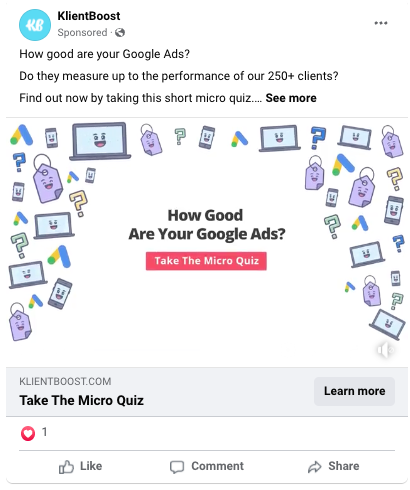
When you click through the ad, it takes you straight to a landing page with the Google Ads quiz. No surprises:
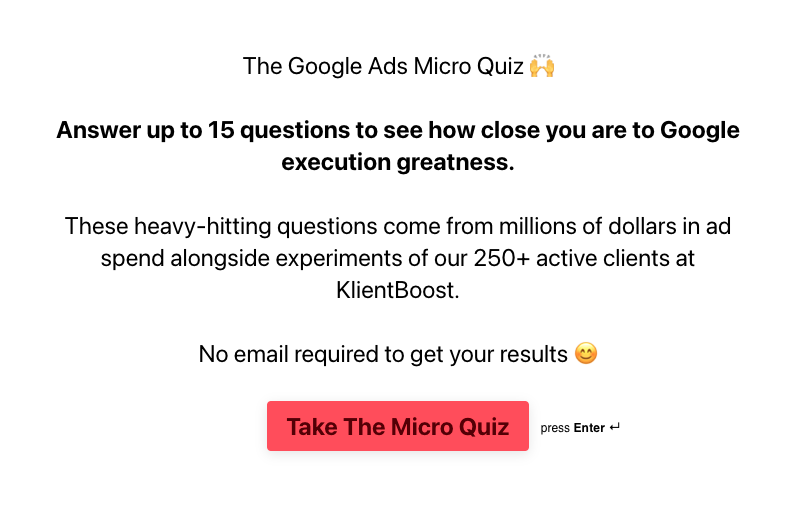
Then there are our ads targeting people looking for an agency:
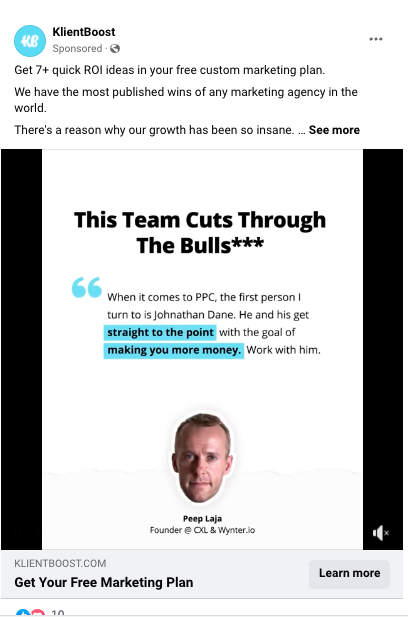
Click through and you'll be taken to our landing page dedicated specifically to a customized marketing plan:
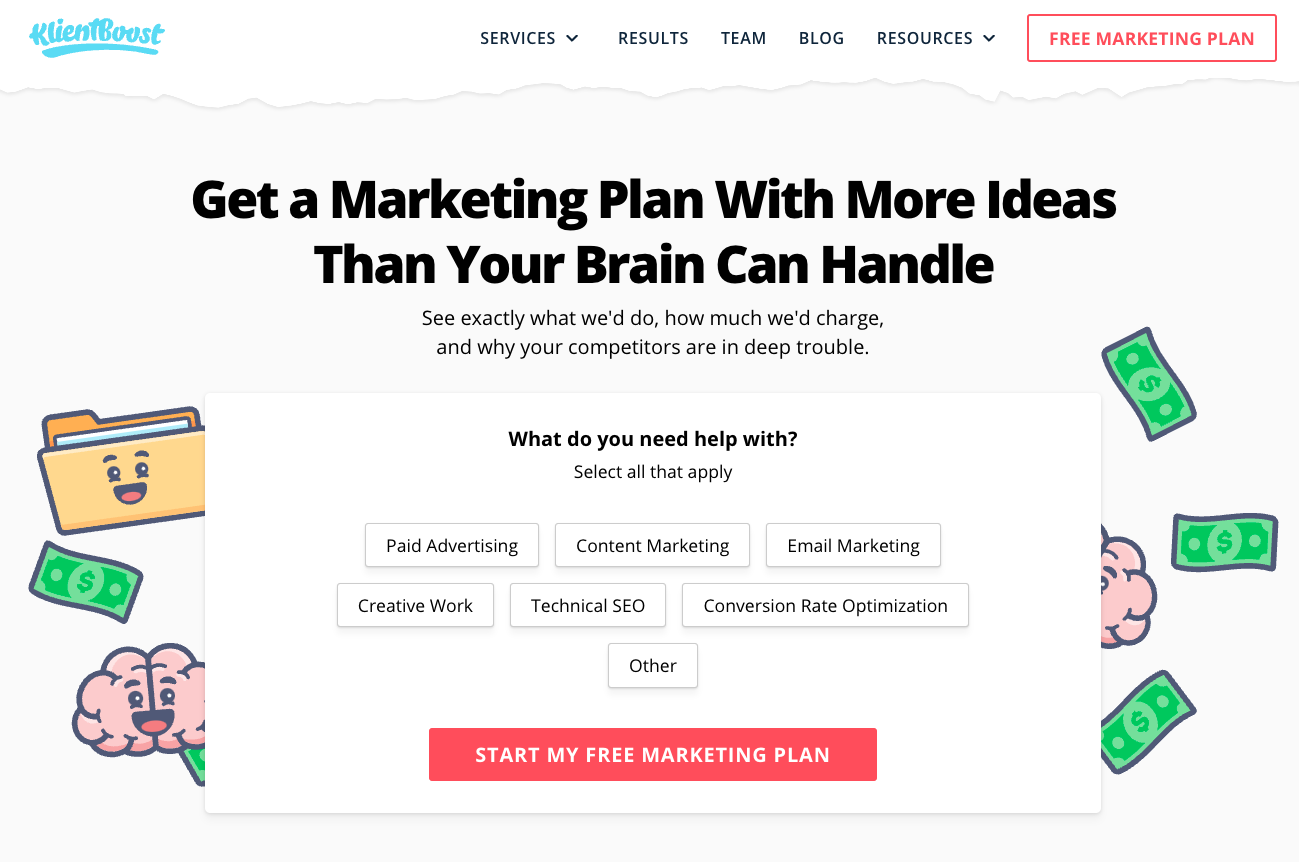
In the example above, you can see when we are targeting a cold audience, we offer a valuable quiz (no email required) rather than dive right in to see if they want a custom proposal. In many cases, brands might have an e-book, whitepaper, checklist, or other lead magnet offer before they have a proposal or demo.
Either way, if I am reading a blog post or taking a quiz, I am probably looking for information on a topic (or proof that KlientBoost is actually successful at what they preach on the blog) and not necessarily ready to convert.
You want to make sure to start off with more low threat requests rather than scare people off by asking for too much upfront.
That being said, there are exceptions to the rule. If your prospect is searching “buy red shoes,” the keyword “buy” itself hints at an intent to do just that. We then have more justification for an ad that says: “Buy Red Shoes at XX” with “Buy Red Shoes” being a keyword phrase that incorporates the intent of the potential viewer.
But as you can see, we have the keyword "proposal" noted on our ads and on the landing page. Although a broad keyword, we're retargeting, so the way we view keywords is slightly different than if we were reaching out to someone unfamiliar with our brand.
8. Match number of variations
Find the magic number for specific dedicated landing pages for ad variations. Less can be more.
KlientBoost A/B tested a series of ads across Google Ads and Facebook for its case studies landing page. It saw a 23% conversion rate on the landing page (under Tip #5).
It goes both ways: you might want multiple landing page variations for one ad. For instance, two people might be drawn to click by the same ad, but require different information on the landing page to move them to conversion.
If I am interested in hiring a marketing specialist, I might be more concerned with their years of experience whereas someone might be more cost-conscious.
This is an example where some variation on the landing page may be warranted. That being said, you do have more real estate to work with on a lander as opposed to an ad, which means you can still include variations in additional elements without changing elements that are already in play for message match.
9. Keep it simple
You don’t have to go all out from the get-go. In fact, when you’re testing, you want to change one element at a time to make sure that you can attribute results to a specific change.
Keep your message clear and concise. People don’t have much time to read.
This doesn’t mean you have to go in for a direct ask right away. For instance, you can ask a question without an answer, and still draw people in. But think about how your target audience will read into a message—take out unnecessary jargon and words.
10. Match with email
There are many articles out there that reference ads to landing page message match, but what about after someone completes an initial conversion?
I mentioned previously how sometimes it benefits to look at the bigger picture of a customer journey. For instance, after I have entered my email to receive an e-book download, that provider can now send me follow-up emails (as long as I approved them to do so, based on CAN-SPAM laws).
More brands are hitting prospects with a multi or omnichannel approach in mind, which means they get targeted on multiple channels throughout their journey so don’t fall behind your competition by not considering the same approach.
Here’s an example of how we engage landing page to email message match…
Let’s say someone starts out on our blog, here is what they will find:
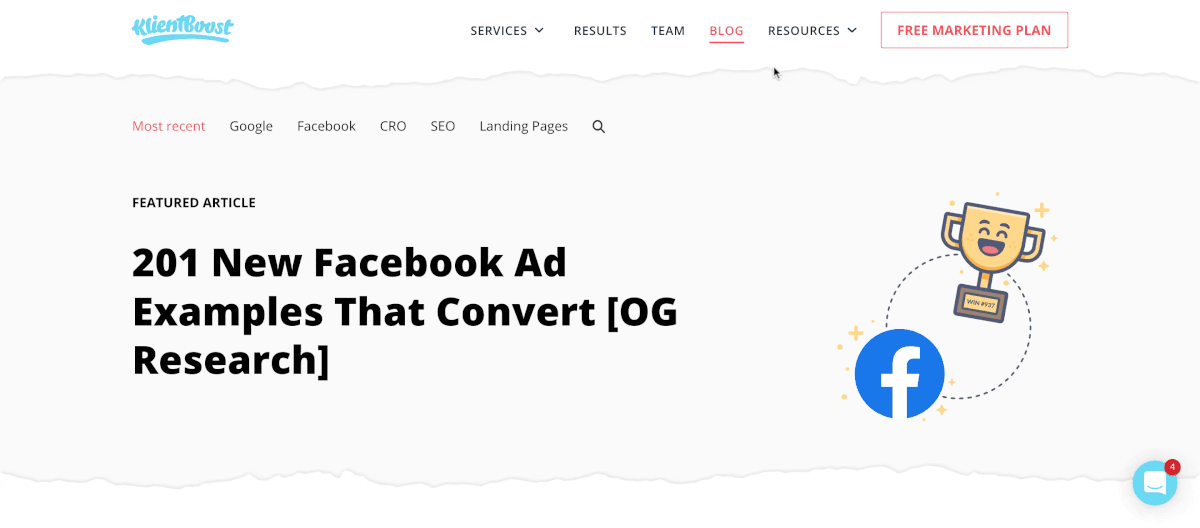
Does it really matter to keep this consistency? People can subconsciously feel something is “off” without knowing why. These subtleties can make a difference in the comfort level of visitors and build their trust in the information we provide on our blog.
Think about it: why would someone put in all this effort to present crappy information? If a brand puts this much care into formatting and consistency, it hopefully speaks to the care they give to the content they provide.
Moving on, if someone then subscribes to our email list on the blog, they’re added to a list where they receive updates when future blog posts get published.
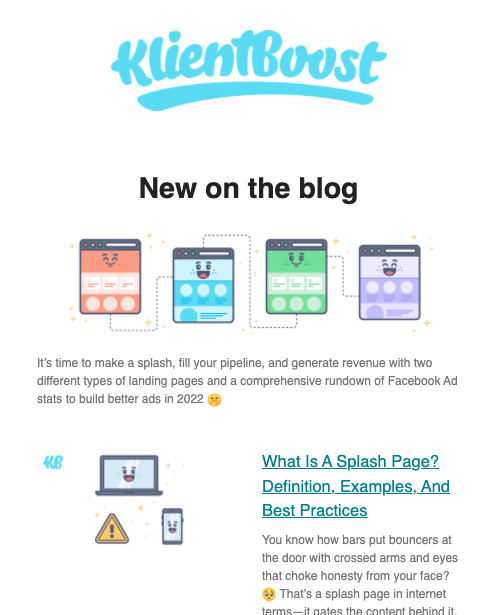
I don’t know about you, but I receive a lot of emails and if it isn’t clear where an email is coming from or why I am receiving it, I am probably going to unsubscribe.
Luckily, there are a few things about this blast that match:
- It utilizes the same images that are on the actual blog post pages.
- The copy has the same casual style that you can find in blog posts
With these emails, we are helping warm up our prospects and, hopefully, move them further down the funnel. Perhaps, a visitor didn’t get enough information from the first blog they read to justify making a conversion. By sending this email, I am providing additional free information to assist with educating and showcasing the expertise of the team at KlientBoost.
11. Make the benefit obvious
Declaring the benefits is what helps separate your message from similar ones your viewers might be digesting. It isn’t about you; it is about them.
Instantly cover what you offer and the value provided, so it’s clear why someone should care about your ad or landing page. Give it serious thought. Is it really just about cost and who offers more features, or is there a more intrinsic need that can be met? If you can tap into that core need, you’re golden.
Whether it’s one element that matches or a combination of them, that is something you will have to test yourself (as performance varies based on several factors: industry, target audience, etc.). Just make sure that the benefit and value the prospect receives is never lost in translation as they carry on in the journey.
Don’t settle for good. Go for a great message match
Anything less than a great message match sets you up for poor results.
Don’t go for gold ⭐️ when you can sparkle in the diamonds category 💎
Diamond-strength message match is about exactly copycatting the PPC ad copy promise (the message) to your landing page headline, subhead, design, and thank you page (the match).
And the reward for that consistent copycatting and campaign clarity is super duper:
- Higher PPC quality score
- Better ad position
- Lower cost per click (CPC)
- Higher conversion rates
- High ROI (return on investment)
There really isn’t a downside to maintaining a marvelous message match. So make your campaigns magical with magnificent message matching that moves your conversion needle toward the muthaf*ckin’ moon.
Then consider these conversion optimization rules you should break.

